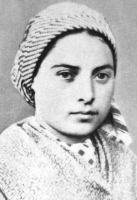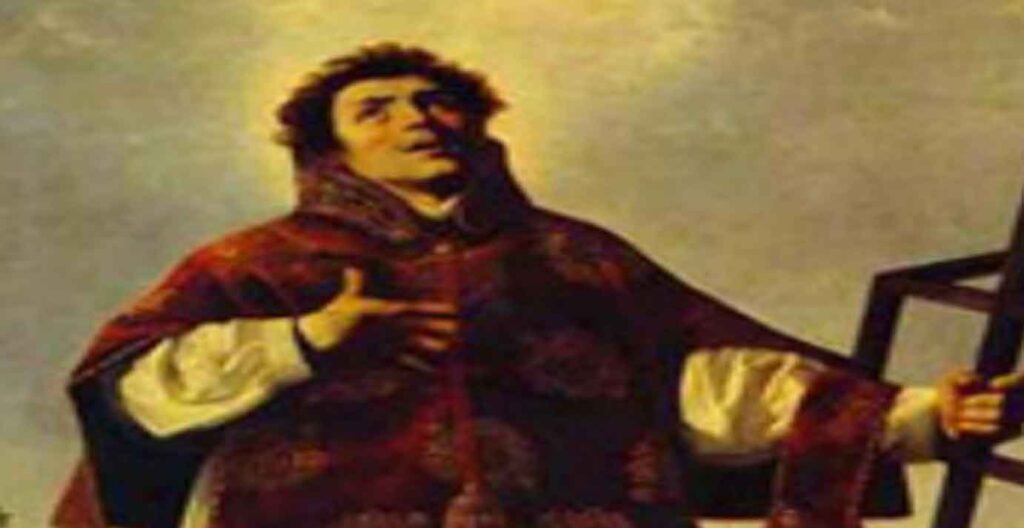Late Second or Early Third Century; Patron Saint of bodily purity, composers, luthiers, martyrs, music, musicians, musical instrument makers, poets, and singers; Pre-Congregation canonization
An ancient tradition holds that Pope Urban I, who served as the Holy Father from about 222–230, built a church in Rome over the house of a virgin martyr named Cecilia. By the fifth century, the church of Santa Cecilia in Trastevere had been either rebuilt or expanded, as it was also in the ninth and sixteenth centuries. The fact that today’s martyr had a church built in her honor, over the house in which she lived and died, helps explain how she has become so revered and honored throughout the many centuries since her death, despite the fact that little is known about her.
All we know for certain about Saint Cecilia is that she lived, was a follower of Christ, and died a martyr. Even the year of her death is disputed. Some place it as early as during the rule of Emperor Marcus Aurelius (176–180); others place it later, during the rule of Emperor Alexander Severus (222–235); still others place it somewhere in between. Though we do not have historical facts, we have an inspiring legend that was written down around the fifth century in a book called The Passion of Saint Cecilia. It is from that legend that this reflection on the life of this holy martyr is based.
Cecelia was born into a wealthy and noble family in the city of Rome during a time when Roman emperors and local prefects often persecuted Christians. Cecilia was not only a Christian with a very deep faith, she fasted, performed other penitential acts, and pledged her life to Christ and Him alone as His bride.
As a young woman, Cecilia’s father gave her in marriage to a nobleman named Valerian against her wishes. Young women at that time did not have the final say about whom they would marry. Like most Romans at that time, Valerian adhered to the Roman pagan religious practices. During their wedding, as the music played, Cecilia sang her own hymn in her heart. It was a hymn of praise to God, a beautiful prayer to her true Spouse in Heaven, which is why she later became the patron saint of musicians. After their wedding, before Valerian attempted to sleep with her, Cecilia revealed to her new husband that she was a Christian and that she had made a vow of virginity to her true heavenly Spouse. What’s more, Cecilia told Valerian that an angel of God was sent to her to guard her virginity, and the angel would deal fiercely with anyone who tried to violate it. Valerian asked to see the angel and Cecilia informed him that there was only one way. He had to go see Pope Urban I, receive catechetical instruction, and be baptized. Pope Urban had been in seclusion, living within the catacombs to avoid persecution and death from the Roman prefect. Valerian found him, was instructed in the faith, and baptized. When he returned to Cecilia, Valerian not only saw the angel who guarded her, he also saw her angel place on her head a dual crown of white lilies, symbolizing her purity, and red roses, symbolizing her martyrdom.
As a new Christian, Valerian shared his faith with his brother, Tiburtius, who also converted and was baptized. Valerian and Tiburtius then became very active with the underground Christian community, devoting themselves to good works, such as burying those who were martyred for their faith. Eventually, they came to the attention of the Prefect Almachius who ordered them to offer sacrifice to the Roman god Jupiter. When they refused, a Roman officer named Maximus was commanded to behead them. When Maximus attempted to carry out the command, he had a heavenly vision that led to his instant conversion. Once he professed his faith, he, too, was martyred with Valerian and Tiburtius by beheading, and Cecilia buried them.
Shortly afterward, Cecilia was arrested. The Prefect Almachius tried to convince her to save her life by offering sacrifice to the Roman gods, but she refused. Almachius was afraid that there might be backlash if he killed her publicly, since she was a beloved member of the community, so he ordered the guards to take her to her home, lock her in her bathroom, and boil water so that the steam would suffocate her, and her death could be blamed on an accident of her own making. The plot backfired and Cecilia survived. Outraged, Almachius ordered her beheading in her home. The soldier was dispatched and struck her neck once, twice, and a third time, but she remained alive, though badly injured. Roman law did not permit a fourth attempt at beheading, so the soldiers left her alone to die.
Cecilia remained alive for the next three days, during which time the Christian community flocked to her home. She distributed all of her money and property to the poor, and donated her house to the pope so he could transform it into a place of Christian worship. Toward the end, she was in such great suffering that she could no longer speak. So, to honor God, she held up her thumb and two fingers to represent the Most Holy Trinity, and her index finger on the other hand to represent the one divine nature they shared.
When she died, she was buried in the Catacomb of Saint Callistus, and Pope Urban transformed her house into a church. Centuries later, in 821, Pope Paschal I moved her mortal remains from the catacomb to the church built by Pope Urban and later expanded. In 1599, in preparation for the jubilee year, Cardinal Paolo Emilio Sfrondati had her body exhumed, and she was found miraculously preserved. Her tomb is now under the main altar with a marble sarcophagus on top, made by the artist Stefano Maderno, who is said to have seen her miraculously preserved body in 1599. The sarcophagus depicts what he saw. She is clothed in a silk and gold dress; her face is turned to the ground. On one hand her three fingers honor the Trinity; on the other, her one finger honors Their shared divinity.
Despite the legendary nature of her story, God has used Saint Cecilia to inspire many through the centuries, and there is little doubt that the details of her life were passed down from generation to generation by word of mouth, until they were finally put in writing. Her name was inserted into the Roman Canon (Eucharistic Prayer I), along with other saints and Roman martyrs. The Basilica of Santa Cecilia in Trastevere remains a revered church in Rome to this day, where many enter to pray and beseech her intercession and are inspired as they kneel before the marble sarcophagus depicting her young martyred body awaiting her final resurrection with Christ, her divine Spouse.
Source: https://mycatholic.life/saints/saints-of-the-liturgical-year/november-22—saint-cecilia–memorial/







